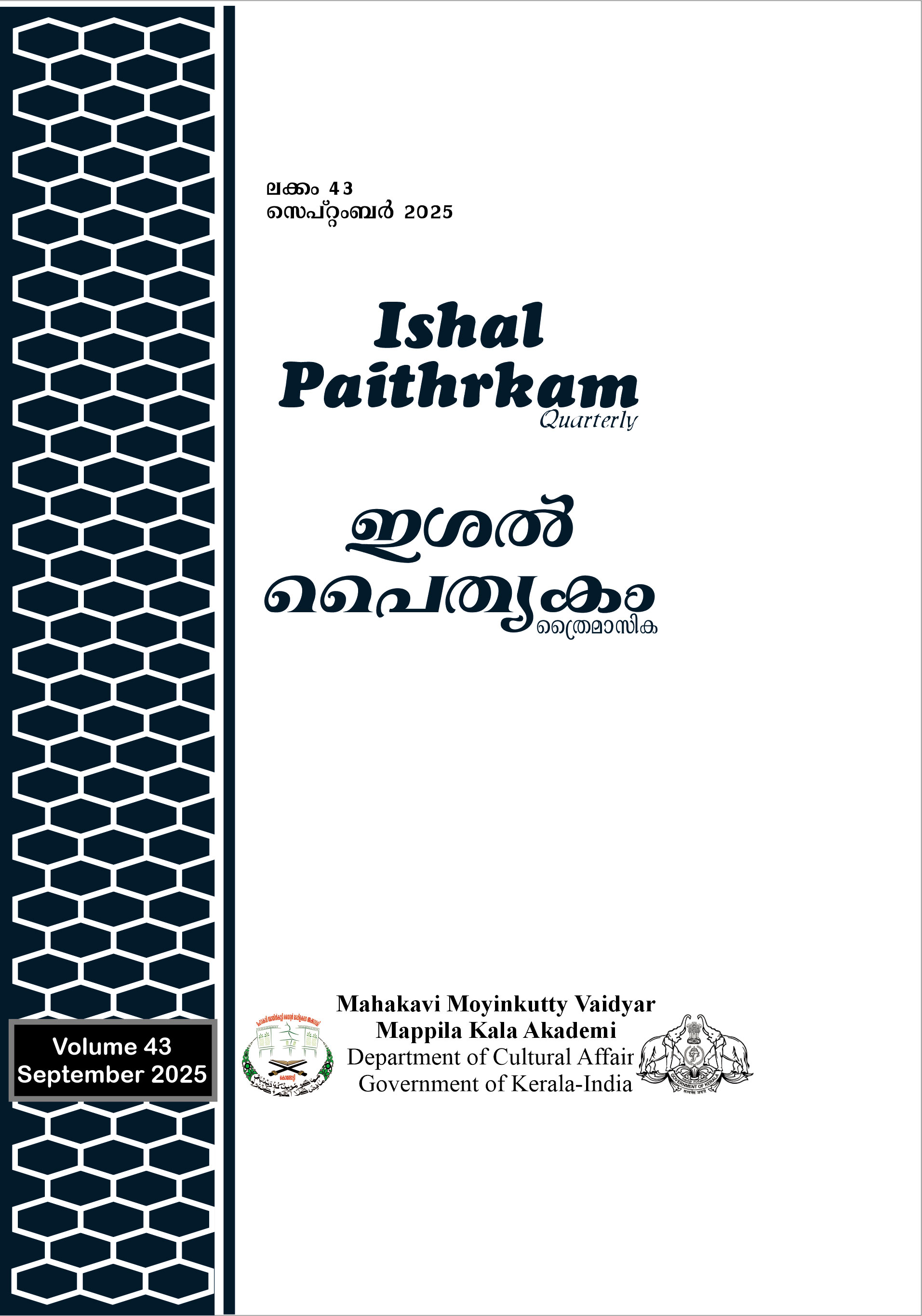Saints and Healing: Hagiographies and Healing Practices of Mappila Muslims in Colonial Malabar
Keywords:
Mappila Muslims, Malabar Region , Hagiographies, Healing, Malappattu, MaulidsAbstract
Writings in praise of holy saints have existed across societies since ancient times. Such works, based on the life stories of saints or religiously revered persons, were often composed to praise their virtues and inspire devotion, sometimes overlooking their shortcomings. Many of these works also serve as historical sources describing the social conditions of their time. However, it is often found that such writings, which include various miraculous deeds of the saint concerned, also contain accounts of their experiences related to illness and treatment. Among the Mappila Muslims of Malabar, hagiographical works such as Malapattus, Maulids, Madhhupattu, and Ratibs were composed during pre-modern times. These texts gained prominence alongside the spread of Sufism in the region, documenting the miracles of holy saints or Sufi Sheikhs, especially their ability to cure diseases. Interestingly, these hagiographical works were often used as tools for treating illnesses, reflecting their integral role in the development of Popular Islam in Malabar. Emerging as part of the region’s cultural symbiosis, they embody the fusion of religious and cultural elements in pre-modern Malabar. Earlier in Arabic, and since the 17th century, starting with the Muhayiddheenmala, the first Arabi-Malayalam work ever discovered, numerous hagiographies have been produced, primarily chronicling the lives and miraculous deeds of Sufi saints. Stories of healing form a central category within these accounts. This tradition persisted through the centuries, including during the period of British colonialism in Malabar. Colonial sources, along with the prevailing social, cultural, and economic conditions, strongly suggest the recurrence of epidemics and diseases, which in turn gave rise to hagiographical works centred on illness, healing, and related themes. This paper examines how hagiographical works contribute to understanding healing practices among the Mappilas of Malabar, employing historiographical and ethnographic methods to analyse their role in shaping healing traditions from the pre-modern era through the colonial period.
Downloads
References
Abdul Razak, P.P. (2007). Colonialism and Community Formation in Malabar: A Study of Muslims of Malabar. [Unpublished doctoral dissertation]. University of Calicut.
Ashton, Gail. (2000). The Generation of Identity in Late Medieval Hagiography. Routledge, London.
Carlyle, Thomas. (1908). On Heroes, Hero Worship and the Heroic in History. JM Dent & Sons, London.
Cornish, W.R. (1871). Cholera in South India: A Record: the Progress of Cholera in 1870. Madras Government Gazetteer Press, 1871; Correspondence Files, C/170, Regional Archives Kozhikode.
Correa, Gasper. (1869). The Three Voyages of Vasco de Gama and his Viceroyalty from the Lands of India (H.E.J. Stanley, Trans.). Hakluyt Society. (Original work published in 1550).
Delehaye, Hippolyte. (1962). The Legends of the Saints (Donald Attawater, Trans.). Fordham university Press, New York.
Dijkstra, Jitse., & Van Dijk, Mathilde. (Eds.). (2006). Egyptian Hagiography and the Medieval West. Brill, Leiden.
Head, Thomas. (1990). Hagiography and the Cult of Saints. Cambridge University Press.
Hitti, Philip K. (1970). History of the Arabs: From the Earliest Times to the Present. Macmillan, London. First published in 1937.
Ho, Engseng. (2006). The Graves of Tarim: Genealogy and Mobility across the Indian Ocean. University of California Press.
Innes, C.A. (1951). Malabar Gazetteer, (F.B. Evans, ed.). Madras Government Press. Fist published in 1908.
Logan, William. (1951). Malabar Manual, vol 2. Government Press, Madras. First published in 1887.
Marwick, Arthur. (1989). The Nature of History. Macmillan, London. First published in 1970.
Meri, Josef W. (2002). The Cult of Saints Among Muslims and Jews in Medieval Syria. Oxford University Press.
Morris Augustine, Jonathan. (2005). Buddhist Hagiography in Early Japan. Routledge Curzon, London.
Palmer, James T. (2018). Early Medieval Hagiography. ARC Humanities Press, Leeds.
Randathani, Hussain. (2018). Muslims of Malabar Society and Politics (1800-1921). B.R.Publishing Corporation, Delhi.
Renard, John. (2005). Historical Dictionary of Sufism. The Scarecrow Press, Maryland.
Rigo, Antonio. (Ed.). (2018). Byzantine Hagiography: Texts, Themes and Projects. Brepols Publishers, Turnhour.
Serjeant, R.B. (1957). The Saiyids of Hadramawt. University of London.
Yasser Arafath, P. (2011). History of Medicine and Hygiene in Medieval Kerala 14th -16th Centuries. [Unpublished Doctoral Dissertaion]. University of Hyderabad.
Yasser Arafath, P.K. (2020). Polyglossic Malabar: Arabi-Malayalam and Muhiyuddinmala in the Age of Transition (1600s-1750s). Journal of the Royal Asiatic Socity (JRAS), Series 3, 30, 3, 517-539.
Downloads
Published
Issue
Section
License
Copyright (c) 2025 ISHAL PAITHRKAM

This work is licensed under a Creative Commons Attribution-NoDerivatives 4.0 International License.

